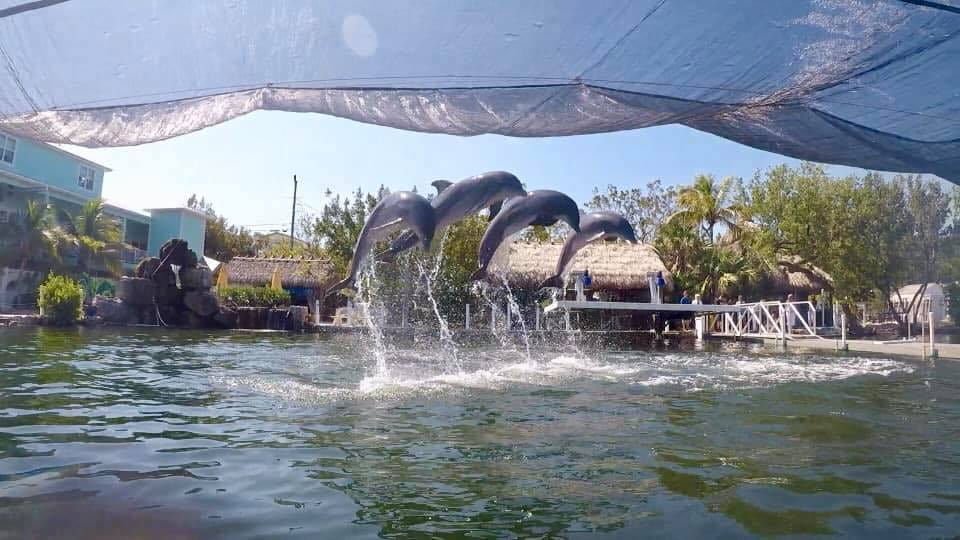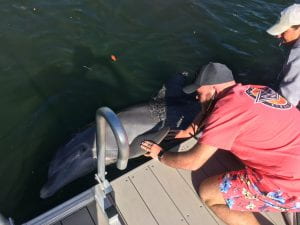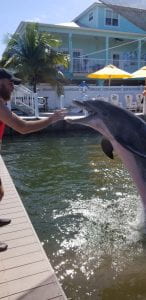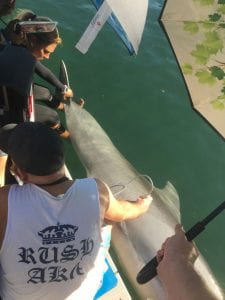Island Dolphin Care in Key Largo, Florida is a not-for-profit organization that offers dolphin-assisted therapy programs to children, adults with special needs, and their families and caregivers. The founders, Deena and Peter Hoagland, created the organization back in 1997 after their son personally experienced the healing powers that dolphin-assisted therapy can offer. At the age of 3, the Hoagland’s son, Joe, suffered a stroke while undergoing his third open-heart surgery resulting in severe weakness on the left side of his body. The Hoagland’s eventually brought Joe to a local dolphin swim facility where he interacted with dolphins as a form of physical therapy. Over time, Joe was able to make a full recovery because of a special bond with a dolphin named Fonzie, which inspired Deena and Peter to provide the same opportunity for others.
In addition to providing therapy swims, Island Dolphin Care hosts approximately 80 students throughout the year from various fields to participate in an introduction to marine mammal medicine course. Students enrolled gain hands-on experience in the veterinary care of Atlantic Bottlenose Dolphins while learning about their anatomy and behavior. Veterinarians, veterinary technicians, and trainers work directly with the students in small groups to educate the next generation of marine mammal enthusiasts. As an aspiring marine mammal and aquatic-focused veterinarian, this introductory experience proved to be truly invaluable and served as an excellent introduction to marine mammal medicine in a real-life clinical setting.
As a first-year veterinary student, I was very nervous and unsure of my potential for success in this program. I hadn’t completed any advanced clinical or diagnostic courses yet and my hands-on veterinary experience up to that point was limited to domestic terrestrial species. However, I felt reassured upon arriving when I discovered that my classmates, all with different backgrounds and experiences, had never worked with dolphins in a clinical setting either.
Every morning, students started their day in the commissary to learn about the feeding protocols. Different fish species were fed in different ratios for nutritional and enrichment purposes and to promote learned behaviors. For example, fatty herring was a large component of most diets because of the high omega-3 fatty acid content. Following this, we would normally make our way to the pool to begin our physical exams. Every day, each student was assigned a different dolphin to conduct a physical exam on. My two favorite dolphins to work with were Sarah and Squirt, the two matriarchs of the pod, because they consistently reminded the trainers that the dolphins were in charge of the relationship. Students were tasked with obtaining relevant history and information from the different trainers prior to their exam and were expected to write full reports with recommended treatments following the exams. We were also charged with evaluating current medications, the purpose for treatment, and recommending changes should any be necessary. I remember my surprise in finding out that female dolphin reproductive physiology is so similar to that of horses, that female dolphins can also take Regumate as a form of birth control while in captivity.
Throughout the week, we also attended lectures focusing on dolphin digestive and reproductive anatomy, how to perform diagnostic testing procedures, and on the learned behaviors that are critical for both medical procedures and enrichment. This information was then used to perform daily ultrasounds on the dolphins. Outside of a basic introduction as a technician before school and then briefly again in school, I barely had any experience with ultrasonography. Despite my lack of prior training, before my week at Island Dolphin Care was over, I was able to conduct a complete digestive and reproductive ultrasound on a dolphin and write a report on my findings.
Later in the week, we were taught how to draw blood from a dolphin’s ventral superficial fluke vein, make a blood smear, and perform cell counts. We also learned how to evaluate erythrocyte sedimentation rate (ESR) test results. This test, which isn’t commonly used in terrestrial veterinary medicine, is a crucial marine mammal diagnostic tool used to detect an inflammatory response by measuring how quickly erythrocytes can settle in a tube overtime.
I’ll never forget the time I spent at Island Dolphin Care because I was able to learn crucial hands-on techniques early in my veterinary education that will help make me a better and more prepared veterinarian. Having learned these skills at a facility like Island Dolphin Care only made the experience more unique and meaningful.
Danny Ruvolo, class of 2022, is a veterinary student originally from Staten Island, New York. Danny received his B.S. in Biology with minors in chemistry and psychology from Fairleigh Dickinson University and his M.B.S. from Rutgers University School of Graduate Studies. He is interested in exotic, zoo, and aquarium medicine and aspires to one day treat as many species as he can.





